Table of contents
- PS technology series part 2 Valve control and gas exchange
- Long valve timing, large valve lifts
- Direct valve control
- As hard as necessary, as soft as possible
- Basics

Yamaha
counselor
technology & future
Valve control gas exchange
PS technology series part 2
Valve control and gas exchange
Content of
Almost exactly four milliseconds remain to fill the combustion chamber of a superbike at 12,000 rpm. This can only be achieved if full throttle is passed through all the bottlenecks at full speed. An excursion to the power center of modern motorcycle engines.
Werner Koch
05/21/2013
You’re still doing the math, aren’t you? In fact, it is hard to believe what is going on between the airbox and the combustion chamber when the valves dance through the combustion chamber at a ludicrous pace and disappear precisely into their seat before the upward-rushing piston knots them. The designers of modern motorcycle engines have worked hard to ensure that the actors survive the fast-paced ballet undamaged even at the highest revs and that the timing is accurately adhered to. Although the valve control systems, which have been tried and tested for decades, are retained, they have been optimized down to the last detail.
Buy complete article
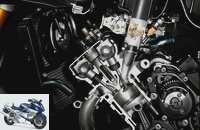
PS technology series part 2
Valve control and gas exchange
6 pages) as PDF
€ 2.00
Buy now
In order to achieve the highest possible degree of filling, the valves should open as quickly as possible and reach their maximum valve lift in order to then snap back into their seat in a flash. Unfortunately, physics sets clear limits to this desire. Due to the inertia of the valves and components of the control (spring and transmission parts), enormous inertia forces develop when the valves are opened and closed.

workshop
PS technology special
Further training for motorcyclists
read more
Long valve timing, large valve lifts
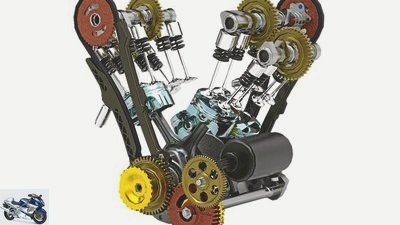
archive
Bucket tappets are the most common type of valve control in dohc engines. Small shims under the bucket tappet are used to correct the valve clearance.
For this reason, the cam is shaped in such a way that the valve train works with as little jerk as possible, i.e. free from extremely high peak accelerations. In all control systems, the cams are divided into six sections. In addition to durability, the engine characteristics as well as exhaust gas and consumption values can be massively influenced via the valve timing. As a rule of thumb, short valve timing and low valve overlap generate a wide torque range with low consumption.
Long control times, large valve lifts and long valve overlaps guarantee high peak performance with increased consumption and limited suitability for everyday use. In addition, due to the open gas exchange in the valve overlap, more or less fresh gas and thus the toxic chlorinated hydrocarbons escape into the exhaust. The control diagram on page 62 clearly shows how the standard and racing cams differ in this regard.
In order to adhere to the valve timing precisely even at the highest speeds, attempts are made to design a drive that is as stiff as possible. It starts with the power transmission from the crankshaft to the camshaft. The best, but also the most expensive solution: gear cascades, such as those used in some Honda V4 engines. Inverted tooth chains with the shortest possible design are currently used. This includes the trick of a gear-driven countershaft (e.g. MV Agusta F3) or the wrapping of just one camshaft around the toothed chain, which drives the counterpart via gear wheels, as in the world championship Aprilia RSV4. The aim of all types of drive is to adhere to the timing exactly and not to delay it through deformation of the components or elongation of the chains.
Direct valve control
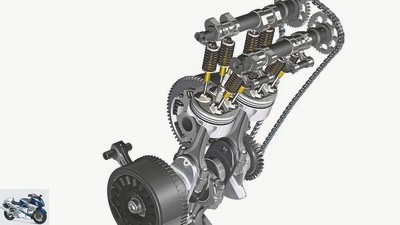
archive
Rocker arm. Mounted between the cam and the valve stem, the delicate components transfer the force to the valve stem like a lever. Here too, shims regulate the valve clearance.
Japanese sports engines are currently only equipped with bucket tappets, also known as “direct valve control” in technical jargon. Robust, reliable and relatively inexpensive to manufacture, this principle has proven itself over decades. Also because the cam rotation does not transfer any transverse forces to the valve stem, which benefits the service life and tightness. The transverse forces are absorbed exclusively by the bucket tappet, which moves up and down in a finely machined hole in the aluminum cylinder head.
BMW and KTM rely on the technology with rocker arms, also known as “indirect valve control”, which are provided with an extremely low-friction DLC (diamond-like carbon) coating. The sum of the oscillating components makes this system lighter than comparable bucket tappet motors. Small disadvantage: The circular movement of the rocker arm on the valve stem creates a transverse force there, which entangles the valve in its guide and thus increases wear.
The valve springs play a crucial role in both systems. Because they ensure that the valves and the control components follow the cam contour exactly even at the highest speeds. The components must not lift off the cam, especially when the valves are closed. On the one hand, this could lead to the exhaust valves closing too late and being destroyed by the piston shooting upwards, or resonance vibrations to build up in which the components no longer work in a non-positive manner, but rather hop over the cam track at a destructive natural frequency.
As hard as necessary, as soft as possible
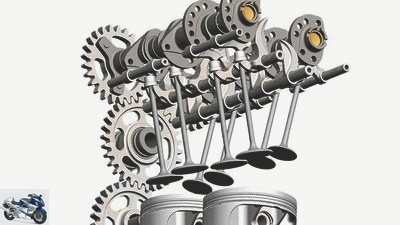
archive
Desmodromic, here in the Ducati MotoGP engine, is the most complex valve control in series production. Fixed speed, exact, but complicated to maintain and set up.
In contrast to earlier times, in which the valve springs were simply pretensioned a little more using spacers when tuning according to Hausmann style, the restoring force of the springs is now calculated to within a tenth of a millimeter and adapted to the cam shape via their continuously progressive winding. Depending on the maximum speed and valve mass, they are either single, as on the Kawasaki Z 1000 engine (maximum speed approx. 11,000 / min), or double, as in the unit of the BMW S 1000 RR (maximum speed approx. 14,000 / min).
In all cases the rule applies: as hard as necessary, as soft as possible. Because springs that are too hard unnecessarily increase wear and friction in the engine. A technical work of art that can do without the valve springs controls the valves at Ducati: the desmodromic. Incredibly elaborately designed, the forced control in the Ducati engines allows extreme control times and valve accelerations with the best speed stability.
In order to reduce the moving masses, titanium valves are often installed in high-performance engines. With the same structural dimensions, they are around 43 percent lighter than the steel valves made of high-strength and temperature-resistant material (steel density 7.85 g / cm³, titanium 4.5 g / cm³). Like the bucket tappets, the valves also have to rotate regularly in their seat for a uniform contact pattern. This is achieved through the rotating action of the valve coil springs during compression and rebound and the use of so-called non-jamming valve cone pieces on the spring plate.
To compensate for the different thermal expansion, the so-called valve clearance is set up between the valve and the cam base circle. If this is too tight, the valves no longer close tightly. In addition, the exhaust valves, which are up to 800 degrees Celsius, can no longer give off their heat to the valve seats and burn up. If the clearance is too large, the valve train hammers and ticks loudly, which also increases the wear and tear on all moving components. Which is also due to the fact that the “ramps” of the camshafts no longer open and descend smoothly enough and the valves slam hard into the seats.
The interplay of control times and the gas flow in the intake port results in a more or less good filling and thus a power output of the engine. The effects of flow-optimized air ducts and intake manifolds were already described in Part 1 (PS 5/2013). The flow area behind the throttle valve, however, is characterized by acute shortage of space compared to the airbox. Finally, in the case of the currently most powerful series engine, the four-cylinder BMW S 1000 RR, it ends at two poppet valves, each with a diameter of just 33.5 millimeters.
However, and therein lies the secret of faster and more drivable racing engines, big is not the same as fast. It is the gas velocity that, in conjunction with flow-optimized ducts, valve seats and combustion chambers, determines the degree of filling. As a practical example of this, PS was allowed to photograph the factory engines of the 750cc Kawasaki ZX-7R superbikes, which prove that it is not big, but slim and cleverly designed channels that make it fast. There, engine technician Kurt Stuckle (www.kurt-stueckle.de) dramatically reduced the size of the inlet and outlet ducts using build-up welding and then optimized the flow by hand. The experienced engine guru saved the work with a high-gloss polished surface for good reason. Many successful engine tuners prefer a flat, interfering edge-free surface with a deliberately fine surface roughness to the sparkling clean polished channels.
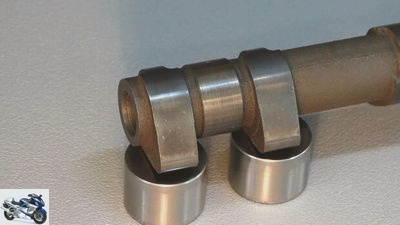
archive
In order to obtain a uniform contact pattern, the cams are slightly offset and thus turn the bucket tappet.
Kurt Stuckle sees reducing the size of the standard channels as a promising method for improving the torque and bandwidth of the engines, even with the large 1000cc superbikes. As proof of the efficiency of relatively slender, uniformly tapering ducts, the measurement of the gas velocities in the intake duct can also be seen in comparison. A flow that is as uniform as possible supports the charging effect, especially at medium speeds, and thereby improves the drivability of the superbikes that are often almost overpowered.
When looking for torque and power, the area around the valve seats is also crucial. Because when you look closely, the large valve disks opening in parallel stand in the way of the air flow and dramatically reduce the arithmetically free cross-section (valve stroke x valve seat circumference). The narrow air gap between the valve disk and the cylinder wall also restricts the incoming fresh gas. It is therefore all the more important to shovel the area from the valve seat to the combustion chamber free, in order to achieve flow conditions that are as free of disruption as possible, even when the opening is small.
These changes can be measured by the so-called flow bench, a test stand that simulates the intake process using negative pressure and measures the amount of air drawn in at different valve lifts. A good example of the mechanically optimal design are the standard CNC-milled combustion chambers of the BMW S 1000 RR engine, in which precisely these subtleties are taken into account, which contribute to the fact that the Bavarian four-cylinder has already risen to the boss in the ring in the series trim.
Basics
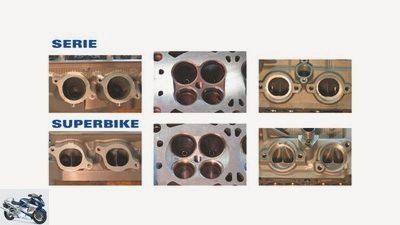
archive
A prime example of how a series engine can be upgraded to a Superbike World Championship engine. Smaller channels and longer dividers in the inlet (left) and outlet (right). Aerodynamically exposed beryllium valve seats in the redesigned combustion chamber of the racing engine.
So that fuller cam profiles can be formed from series components for racing purposes, these are reduced in the base circle and the cam is re-ground. However, since a base circle that is too small creates unfavorable geometrical conditions, the cams can also be changed as required by build-up welding and subsequent grinding. Racing camshafts are often so-called “built” Waves. Prefabricated cams are pressed onto a hollow shaft.
The valve spread indicates how many crankshaft angular degrees the maximum intake valve lift after top dead center (TDC) or the maximum exhaust valve lift after bottom dead center (BDC).
The base circle of many camshafts is interrupted by oil pockets that transport the lubricating oil onto the cam track, which reduces the friction when the valves are opened. Because it is precisely in this area that the highest valve acceleration occurs and thus also an enormous surface pressure between the cam and bucket tappet or rocker arm.
Valve seats usually consist of three milled angles (e.g. 15-45-75 degrees). The seat becomes more aerodynamic, however, if the angles are rounded and only the 45-degree seat angle remains with the smallest possible contact surface for the valve. Attempts are sometimes made to improve the gas flow in detail by rounding the valve disks.
Valve springs with progressive windings are always installed with the narrow windings facing down in order to limit the oscillating masses. A similar effect is achieved with conically coiled springs.
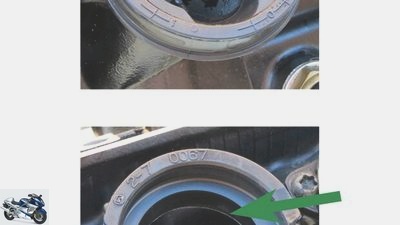
archive
Due to tolerances in the molds, there are often interfering edges (red arrow) in the intake duct in large-scale production. By adjusting the rubber connector on the two fastening screws (white arrows), the transition is leveled out (green arrow) and the flow is improved.
Anyone who is thinking of helping their athletes on the jumps in terms of performance should be aware that high performance is not everything. Motorcycles with more than 150 hp should rather be trimmed towards increasing torque and drivability. And that is not a task for the do-it-yourselfer, but for experienced tuning specialists. Anyone who lends a hand should be careful not to simply start milling with the flexible shaft. Even small corrections, for example to the intake manifold, often result in measurable increases in torque and power. The rubber nozzles are mounted by widening the mounting holes in such a way that the interfering edge disappears (green arrow). Mounted centrally, the transition from the nozzle to the mostly larger diameter of the inlet duct is leveled out. If the motorcycle is used in a racing class that prohibits any changes to the engine parts in the regulations, the thread of the fastening screws in the area of the flange can also be turned to the core diameter, which means that the flange can be moved over an area of almost one millimeter.
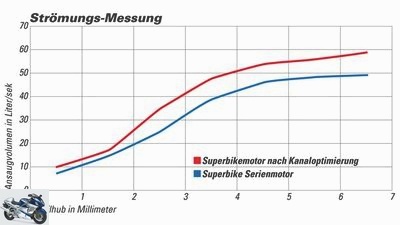
archive
Flow measurement of a current 1000 superbike engine.
Flow measurement of a current 1000 superbike engine on the flow bench before and after the canal rework.
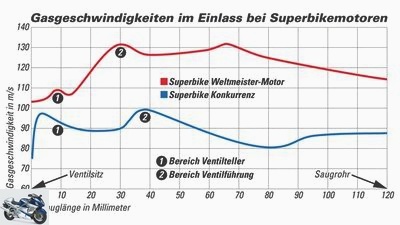
archive
The powerful and powerful engine of a multiple Superbike world champion.
In comparison: the powerful and powerful engine of a multiple Superbike world champion (red) and the test engine of a competing company (blue), which is equipped with channels that are too large, which has withdrawn after a short, unsuccessful interlude.
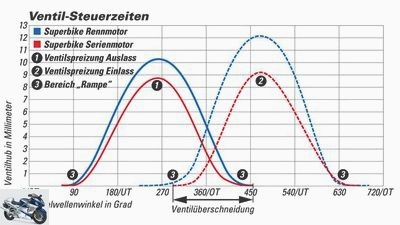
archive
Racing engine (blue) trimmed for high performance compared to the series (red).
With a larger valve lift and longer valve timing, the racing engine (blue) is trimmed for high performance compared to the series (red). Cam spread and valve overlap are further features of a valve lift curve. They can be changed by turning the sprockets with elongated holes.
Related articles
-
Screwdriver tip on the subject of valve control
Ralf Petersen 15th pictures Ralf Petersen 1/15 The valve train controls the gas exchange in a four-stroke engine with the help of the inlet and outlet…
-
Suzuki patent: Variable valve control 2.0
Suzuki 8th pictures Suzuki 1/8 Suzuki is working on a new variable valve control. Suzuki 2/8 It should serve the inlet and outlet and be hydraulically…
-
Technology development in valve actuation
factstudio.de 23 pictures Katrin Sdun 1/23 Before valve actuation via rocker arms prevailed, numerous other designs determined the state of the art. Ralf…
-
Ducati 10 pictures Ducati 1/10 …compact, rotatable hydraulic units on each camshaft, variable timing. The pulse generators for the position of the…
-
MotoGP technology: valve trains
counselor workshop MotoGP technology: valve trains MotoGP technology: valve trains Sex offender Stoner? Traction control? Tire technology? Happiness? It…
-
Adjust the valve clearance on the BMW boxer
Schermer counselor workshop Adjust the valve clearance on the BMW boxer Screwdriver tip Adjust the valve clearance on the BMW boxer Thanks to the exposed…
-
Honda patent new variable valve timing
Honda 12th pictures Honda 1/12 Honda has patented a new variable valve control. Honda 2/12 The new variable valve control in the engine of the upcoming…
-
Flashing electronics tuning chip control unit
Bilski accesories Flashing electronics tuning chip control unit Electronics tuning, chip, control unit Flash, flash, flash! Content of Overwriting…
-
Ducati Multistrada V4 recall: engine replacement after valve problems
Ducati 45 pictures Ducati 1/45 Ducati brings the new Multistrada with a V4 engine. Ducati 2/45 Ducati has made the Multistrada even more versatile….
-
Readers call to ABS control units
MOTORCYCLE archive counselor traffic & business Readers call to ABS control units Readers call to ABS control units Your experiences are in demand For a…